MSDS 安全数据表 Araldit CY 8043_808037_E
- 格式:doc
- 大小:167.50 KB
- 文档页数:7
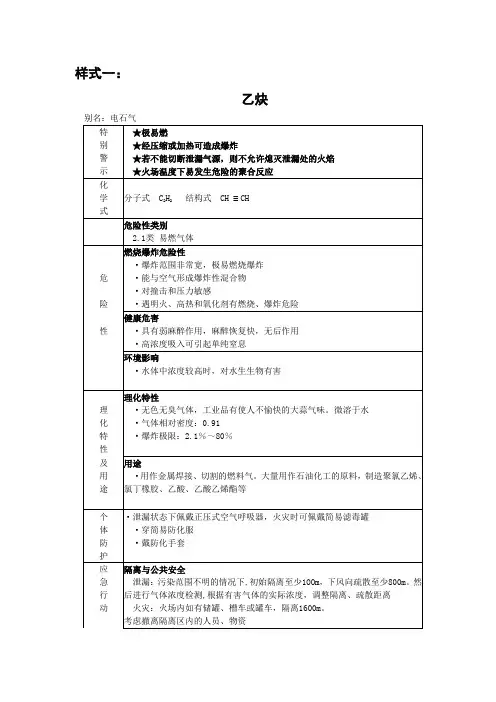
样式一:乙炔别名:电石气特别警示★极易燃★经压缩或加热可造成爆炸★若不能切断泄漏气源,则不允许熄灭泄漏处的火焰★火场温度下易发生危险的聚合反应化学式分子式 C2H2结构式 CH ≡CH危险性类别2.1类易燃气体危险燃烧爆炸危险性·爆炸范围非常宽,极易燃烧爆炸·能与空气形成爆炸性混合物·对撞击和压力敏感·遇明火、高热和氧化剂有燃烧、爆炸危险性健康危害·具有弱麻醉作用,麻醉恢复快,无后作用·高浓度吸入可引起单纯窒息环境影响·水体中浓度较高时,对水生生物有害理化特性理化特性·无色无臭气体,工业品有使人不愉快的大蒜气味。
微溶于水·气体相对密度:0.91·爆炸极限:2.1%~80%及用途用途·用作金属焊接、切割的燃料气。
大量用作石油化工的原料,制造聚氯乙烯、氯丁橡胶、乙酸、乙酸乙烯酯等个体防护·泄漏状态下佩戴正压式空气呼吸器,火灾时可佩戴简易滤毒罐·穿简易防化服·戴防化手套应急行动隔离与公共安全泄漏:污染范围不明的情况下,初始隔离至少1OOm,下风向疏散至少800m。
然后进行气体浓度检测,根据有害气体的实际浓度,调整隔离、疏散距离火灾:火场内如有储罐、槽车或罐车,隔离1600m。
考虑撤离隔离区内的人员、物资·疏散无关人员并划定警戒区·在上风处停留泄漏处理·消除所有点火源(泄漏区附近禁止吸烟,消除所有明火、火花或火焰) ·使用防爆的通讯工具·作业时所有设备应接地·在确保安全的情况下,采用关阀、堵漏等措施,以切断泄漏源·防止气体通过通风系统扩散或进入限制性空间·喷雾状水改变泄漏气体流向·隔离泄漏区直至气体散尽火灾扑救灭火剂:干粉、二氧化碳、雾状水、泡沫·若不能切断泄漏气源,则不允许熄灭泄漏处的火焰·在确保安全的前提下,将容器移离火场·用大量水冷却容器,直至火灾扑灭·安全阀发出声响或容器变色,立即撤离急救·吸入:迅速脱离现场至空气新鲜处。
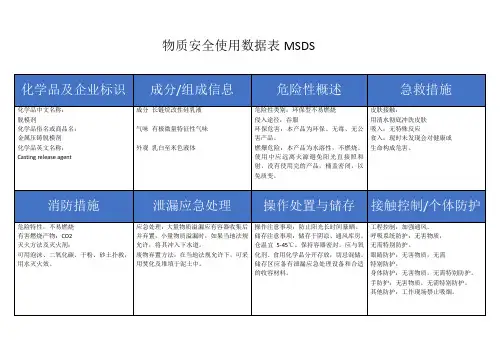
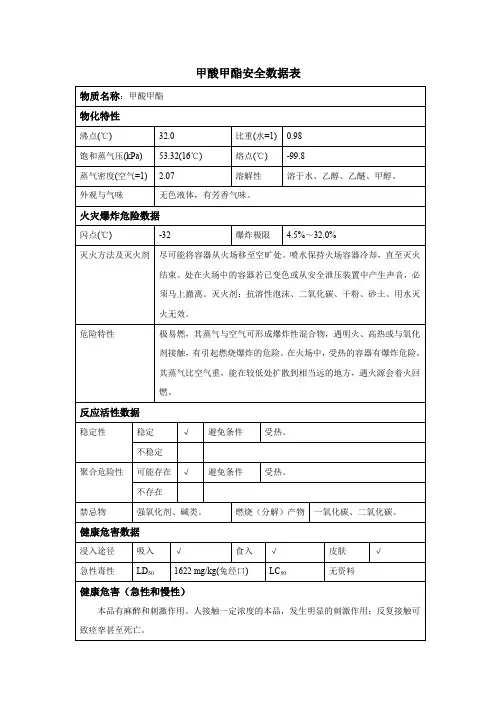

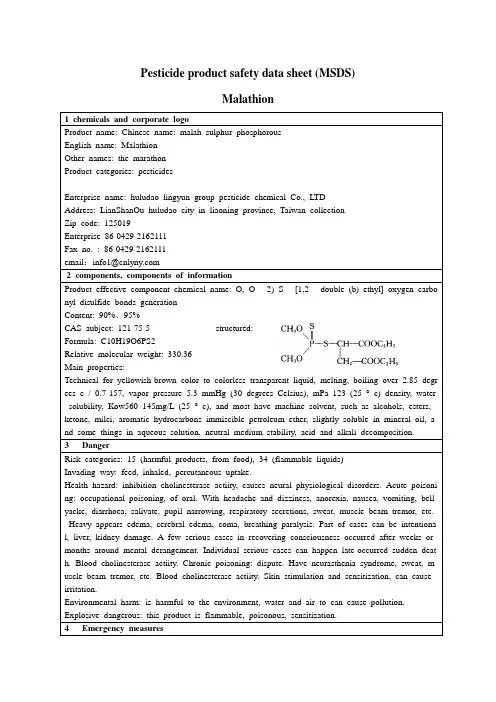
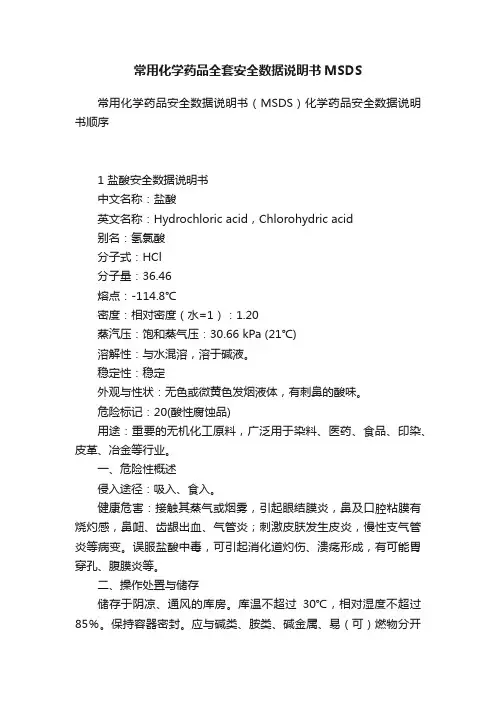
常用化学药品全套安全数据说明书MSDS常用化学药品安全数据说明书(MSDS)化学药品安全数据说明书顺序1 盐酸安全数据说明书中文名称:盐酸英文名称:Hydrochloric acid,Chlorohydric acid别名:氢氯酸分子式:HCl分子量:36.46熔点:-114.8℃密度:相对密度(水=1):1.20蒸汽压:饱和蒸气压:30.66 kPa (21℃)溶解性:与水混溶,溶于碱液。
稳定性:稳定外观与性状:无色或微黄色发烟液体,有刺鼻的酸味。
危险标记:20(酸性腐蚀品)用途:重要的无机化工原料,广泛用于染料、医药、食品、印染、皮革、冶金等行业。
一、危险性概述侵入途径:吸入、食入。
健康危害:接触其蒸气或烟雾,引起眼结膜炎,鼻及口腔粘膜有烧灼感,鼻衄、齿龈出血、气管炎;刺激皮肤发生皮炎,慢性支气管炎等病变。
误服盐酸中毒,可引起消化道灼伤、溃疡形成,有可能胃穿孔、腹膜炎等。
二、操作处置与储存储存于阴凉、通风的库房。
库温不超过30℃,相对湿度不超过85%。
保持容器密封。
应与碱类、胺类、碱金属、易(可)燃物分开存放,切忌混储。
储区应备有泄漏应急处理设备和合适的收容材料。
三、急救措施皮肤接触:立即用水冲洗至少15分钟。
或用2%碳酸氢钠溶液冲洗。
若有灼伤,就医。
眼睛接触:立即提起眼睑,用流动清水冲洗10分钟或用2%碳酸氢钠溶液冲洗。
吸入:迅速脱离现场至空气新鲜处。
呼吸困难时给输氧。
给予2-4%碳酸氢钠溶液雾化吸入。
就医。
食入:误服者立即漱口,给牛奶、蛋清、植物油等口服,不可催吐。
立即就医。
四、消防措施危险特性:能与一些活性金属粉末发生反应,放出氢气。
遇氰化物能产生剧毒的氰化氢气体。
与碱发生中合反应,并放出大量的热。
具有强腐蚀性。
燃烧(分解)产物:氯化氢。
用碱性物质如碳酸氢钠、碳酸钠、消石灰等中和。
也可用大量水扑救。
灭火方法:雾状水、砂土。
五、防护措施呼吸系统防护:可能接触其蒸气或烟雾时,必须佩戴防毒面具或供气式头盔。
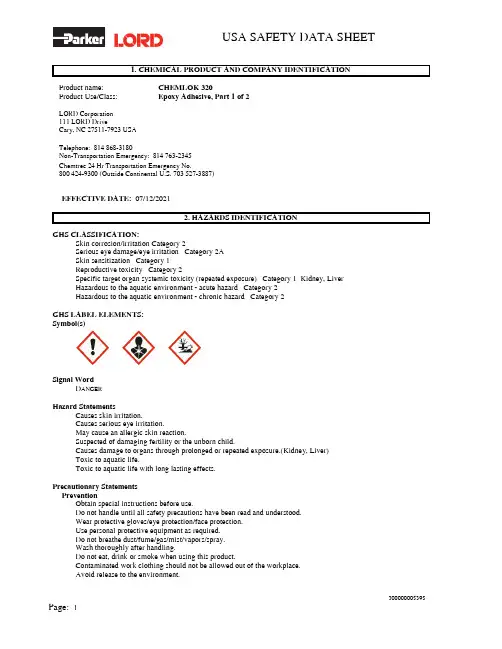
USA SAFETY DATA SHEET3000000053951. CHEMICAL PRODUCT AND COMPANY IDENTIFICATIONProduct name: CHEMLOK 320Product Use/Class:Epoxy Adhesive, Part 1 of 2LORD Corporation 111 LORD DriveCary, NC 27511-7923 USATelephone: 814 868-3180Non-Transportation Emergency: 814 763-2345 Chemtrec 24 Hr Transportation Emergency No.800 424-9300 (Outside Continental U.S. 703 527-3887)EFFECTIVE DATE: 07/12/20212. HAZARDS IDENTIFICATIONGHS CLASSIFICATION:Skin corrosion/irritation Category 2Serious eye damage/eye irritation Category 2A Skin sensitization Category 1 Reproductive toxicity Category 2Specific target organ systemic toxicity (repeated exposure) Category 1 Kidney, Liver Hazardous to the aquatic environment - acute hazard Category 2 Hazardous to the aquatic environment - chronic hazard Category 2GHS LABEL ELEMENTS: Symbol(s)Signal WordD ANGERHazard StatementsCauses skin irritation.Causes serious eye irritation.May cause an allergic skin reaction.Suspected of damaging fertility or the unborn child.Causes damage to organs through prolonged or repeated exposure.(Kidney, Liver) Toxic to aquatic life.Toxic to aquatic life with long lasting effects.Precautionary Statements PreventionObtain special instructions before use.Do not handle until all safety precautions have been read and understood. Wear protective gloves/eye protection/face protection. Use personal protective equipment as required. Do not breathe dust/fume/gas/mist/vapors/spray. Wash thoroughly after handling.Do not eat, drink or smoke when using this product.Contaminated work clothing should not be allowed out of the workplace. Avoid release to the environment.ResponseGet medical advice/attention if you feel unwell.IF exposed or concerned: Get medical advice/attention.Specific treatment (see supplemental first aid instructions on this label).IF ON SKIN: Wash with plenty of soap and water.If skin irritation or rash occurs: Get medical advice/attention.IF IN EYES: Rinse cautiously with water for several minutes. Remove contact lenses, if present and easy to do.Continue rinsing.If eye irritation persists: Get medical advice/attention.Take off contaminated clothing and wash before reuse.Collect spillage.StorageStore locked up.Disposal:Dispose of contents/container in accordance with waste/disposal laws and regulations of your country or particular locality.Other Hazards:This product contains component(s) which have the following warnings; however based on the GHS classification criteria of your country or locale, the product mixture may be outside the respective category(s).Acute: Vapor harmful; may affect the brain or nervous system causing dizziness, headache or nausea. Dermalabsorption possible. May cause respiratory tract irritation. May be harmful if swallowed. Ingestion is not an expected route of entry in industrial or commercial uses.Chronic: Prolonged or repeated contact may result in dermatitis. May cause kidney damage. IARC has designated titanium dioxide (TiO2) as Group 2B – possibly carcinogenic to humans in dust form. However, a number of long term animal studies and human epidemiology studies evaluating TiO2 and workplace exposure show insufficientevidence for carcinogenic effects. EPA, NTP and OSHA do not designate TiO2 as a carcinogen and ACGIHdesignates TiO2 as A4 - not classifiable as a human carcinogen. Mortaility from other chronic diseases, including other respiratory diseases, was not associated with exposure to TiO2 dust. TiO2 is not present in this product as a dust and no airborne exposure is expected during application.3. COMPOSITION/INFORMATION ON INGREDIENTSChemical Name CAS Number RangeEpoxy resin PROPRIETARY55 - 60%Diol PROPRIETARY 1 - 5%Titanium dioxide13463-67-70.1 - 0.9%Any "PROPRIETARY" component(s) in the above table is considered trade secret, thus the specific chemical and its exact concentration is being withheld.4. FIRST AID MEASURESFIRST AID - EYE CONTACT: Flush eyes immediately with large amount of water for at least 15 minutes holding eyelids open while flushing. Get prompt medical attention.FIRST AID - SKIN CONTACT: Flush contaminated skin with large amounts of water while removing contaminated clothing. Wash affected skin areas with soap and water. Get medical attention if symptoms occur.FIRST AID - INHALATION: Move person to fresh air. Restore and support continued breathing. If breathing is difficult, give oxygen. Get immediate medical attention.FIRST AID - INGESTION: If swallowed, do not induce vomiting. Call a physician or poison control center immediately for further instructions. Never give anything by mouth if victim is rapidly losing consciousness, unconscious or convulsing.5. FIRE-FIGHTING MEASURESSUITABLE EXTINGUISHING MEDIA: Carbon Dioxide, Dry Chemical, Foam, Water FogUNSUITABLE EXTINGUISHING MEDIA: Not determined for this product.SPECIFIC HAZARDS POSSIBLY ARISING FROM THE CHEMICAL: Keep containers tightly closed. Closed containers may rupture when exposed to extreme heat. Use water spray to keep fire exposed containers cool. During a fire, irritating and/or toxic gases and particulate may be generated by thermal decomposition or combustion.SPECIAL PROTECTIVE EQUIPMENT AND PRECAUTIONS FOR FIRE-FIGHTERS: Wear full firefighting protective clothing, including self-contained breathing apparatus (SCBA). If water is used, fog nozzles are preferable.6. ACCIDENTAL RELEASE MEASURESPERSONAL PRECAUTIONS, PROTECTIVE EQUIPMENT AND EMERGENCY PROCEDURES: Avoid contact. Avoid breathing vapors. Use appropriate respiratory protection for large spills or spills in confined area.ENVIRONMENTAL PRECAUTIONS: Do not contaminate bodies of water, waterways, or ditches, with chemical or used container.METHODS AND MATERIALS FOR CONTAINMENT AND CLEANUP: Keep non-essential personnel a safe distance away from the spill area. Notify appropriate authorities if necessary. Avoid contact. Before attempting cleanup, refer to hazard caution information in other sections of the SDS form. Scoop spilled material into an appropriate container for proper disposal. (If necessary, use inert absorbent material to aid in containing the spill).7. HANDLING AND STORAGEHANDLING: Keep closure tight and container upright to prevent leakage. Avoid skin and eye contact. Wash thoroughly after handling. Do not handle until all safety precautions have been read and understood. Empty containers should not be re-used. Use with adequate ventilation.STORAGE: Store only in well-ventilated areas. Keep container closed when not in use.INCOMPATIBILITY: Amines, acids, water, hydroxyl, or active hydrogen compounds.; Strong acids, bases, and strong oxidizers.8. EXPOSURE CONTROLS/PERSONAL PROTECTIONCOMPONENT EXPOSURE LIMITChemical Name ACGIH TLV-TWA ACGIH TLV-STELOSHA PEL-TWAOSHA PEL-CEILINGSkinEpoxy resin N.E.N.E.N.E. N.E.N.A.Diol N.E.N.E.N.E. N.E.N.A.Titanium dioxide10 mg/m3N.E.15 mg/m3 N.E.N.A.N.A. - Not Applicable, N.E. - Not Established, S - Skin DesignationEngineering controls: Sufficient ventilation in pattern and volume should be provided in order to maintain air contaminant levels below recommended exposure limits.PERSONAL PROTECTION MEASURES/EQUIPMENT:RESPIRATORY PROTECTION: Use a NIOSH approved air-purifying organic vapor respirator if occupational limits are exceeded. For emergency situations, confined space use, or other conditions where exposure limits may be greatly exceeded, use an approved air-supplied respirator. For respirator use observe OSHA regulations (29CFR1910.134) or use in accordance with applicable laws and regulations of your country or particular locality.SKIN PROTECTION: Use neoprene, nitrile, or rubber gloves to prevent skin contact.EYE PROTECTION: Use safety eyewear including safety glasses with side shields and chemical goggles where splashing may occur.OTHER PROTECTIVE EQUIPMENT: Use disposable or impervious clothing if work clothing contamination is likely. Remove and wash contaminated clothing before reuse.HYGIENIC PRACTICES: Wash hands before eating, smoking, or using toilet facility. Food or beverages should not be consumed anywhere this product is handled or stored. Wash thoroughly after handling.9. PHYSICAL AND CHEMICAL PROPERTIESTypical values, not to be used for specification purposes.ODOR: Mild VAPOR PRESSURE: N.D.APPEARANCE: White VAPOR DENSITY: Heavier than Air PHYSICAL STATE: Paste LOWER EXPLOSIVE LIMIT: Not ApplicableUPPER EXPLOSIVE LIMIT: Not ApplicableFLASH POINT:≥ 201 °F, 93 °CSetaflash Closed CupBOILING RANGE: N.A.EVAPORATION RATE: Slower than n-butyl-acetate AUTOIGNITION TEMPERATURE:N.D.DENSITY: 1.53 g/cm3 (12.76 lb/gal) DECOMPOSITION TEMPERATURE:N.D. VISCOSITY, DYNAMIC: N.D.ODOR THRESHOLD: N.D.VISCOSITY, KINEMATIC: N.D.SOLUBILITY IN H2O: Insoluble VOLATILE BY WEIGHT: 0.00 %pH: N.A.VOLATILE BY VOLUME: 0.00 %FREEZE POINT: N.D. VOC CALCULATED: 0 lb/gal, 0 g/l COEFFICIENT OF WATER/OILN.D.DISTRIBUTION:LEGEND: N.A. - Not Applicable, N.E. - Not Established, N.D. - Not Determined10. STABILITY AND REACTIVITYHAZARDOUS POLYMERIZATION: Hazardous polymerization will not occur under normal conditions. STABILITY: Product is stable under normal storage conditions.CONDITIONS TO AVOID: High temperatures.INCOMPATIBILITY: Amines, acids, water, hydroxyl, or active hydrogen compounds.; Strong acids, bases, and strong oxidizers.HAZARDOUS DECOMPOSITION PRODUCTS: Carbon monoxide, carbon dioxide, aldehydes, Metal oxides11. TOXICOLOGICAL INFORMATIONEXPOSURE PATH: Refer to section 2 of this SDS.SYMPTOMS:Refer to section 2 of this SDS.TOXICITY MEASURES:Chemical Name LD50/LC50Epoxy resin Oral LD50: Rat11,400 mg/kgDiol Oral LD50: Rat12,565 mg/kgDermal LD50: Rabbit11,890 mg/kgInhalation LC50: Rat> 4,600 mg/m3/4 hTitanium dioxide Oral LD50: Rat> 10,000 mg/kgDermal LD50: rabbit> 5,000 mg/kgGHS LC50 (vapour): Acute toxicity point estimate55 mg/lGerm cell mutagenicity: No classification proposedCarcinogenicity: No classification proposedReproductive toxicity: Category 2 - Suspected of damaging fertility or the unborn child.Components contributing to classification: Diol.12. ECOLOGICAL INFORMATIONECOTOXICITY:Chemical Name EcotoxicityEpoxy resin Invertebrates: Daphnia magna1.7 mg/l48 hDiol Fish: Pimephales promelas75,200 mg/l96 h flow-throughInvertebrates: Daphnia magna84,000 mg/l48 hTitanium dioxide N.D.PERSISTENCE AND DEGRADABILITY:Not determined for this product.BIOACCUMULATIVE: Not determined for this product.MOBILITY IN SOIL: Not determined for this product.OTHER ADVERSE EFFECTS: Not determined for this product.13. DISPOSAL CONSIDERATIONSDISPOSAL METHOD: Disposal should be done in accordance with Federal (40CFR Part 261), state and local environmental control regulations. If waste is determined to be hazardous, use licensed hazardous waste transporter and disposal facility.14. TRANSPORT INFORMATIONUS DOT RoadProper Shipping Name: Environmentally hazardous substances, liquid, n.o.s.Hazard Class: 9SECONDARY HAZARD: NoneUN/NA Number: 3082Packing Group: IIIEmergency Response Guide Number: 171For US DOT non-bulk road shipments this material may be classified as NOT REGULATED. For the mostaccurate shipping information, refer to your transportation/compliance department regarding changes inpackage size, mode of shipment or other regulatory descriptors.IATA CargoPROPER SHIPPING NAME: Environmentally hazardous substance, liquid, n.o.s.Hazard Class: 9HAZARD CLASS: NoneUN NUMBER: 3082PACKING GROUP: IIIEMS: 9LIMDGPROPER SHIPPING NAME: Environmentally hazardous substance, liquid, n.o.s.Hazard Class: 9HAZARD CLASS: NoneUN NUMBER: 3082PACKING GROUP: IIIEMS: F-AThe listed transportation classification applies to non-bulk shipments. It does not address regulatory variations due to changes in package size, mode of shipment or other regulatory descriptors. For the most accurate shipping information, refer to your transportation/compliance department.15. REGULATORY INFORMATIONU.S. FEDERAL REGULATIONS: AS FOLLOWS:SARA SECTION 313This product contains the following substances subject to the reporting requirements of Section 313 of Title III of the Superfund Amendment and Reauthorization Act of 1986 and 40 CFR part 372.:NoneTOXIC SUBSTANCES CONTROL ACT:INVENTORY STATUSThe chemical substances in this product are on the active TSCA Section 8 Inventory or exempt.EXPORT NOTIFICATIONThis product contains the following chemical substances subject to the reporting requirements of TSCA 12(B) if exported from the United States:None16. OTHER INFORMATIONUnder HazCom 2012 it is optional to continue using the HMIS rating system. It is important to ensure employees have been trained to recognize the different numeric ratings associated with the HazCom 2012 and HMIS schemes.HMIS RATINGS - HEALTH: 2* FLAMMABILITY: 1 PHYSICAL HAZARD: 0* - Indicates a chronic hazard; see Section 2Revision: Company LogoEffective Date: 07/12/2021DISCLAIMERThe information contained herein is, to the best of our knowledge and belief, accurate. However, since the conditions of handling and use are beyond our control, we make no guarantee of results, and assume no liability for damages incurred by use of this material. It is the responsibility of the user to comply with all applicable federal, state and local laws and regulations.。
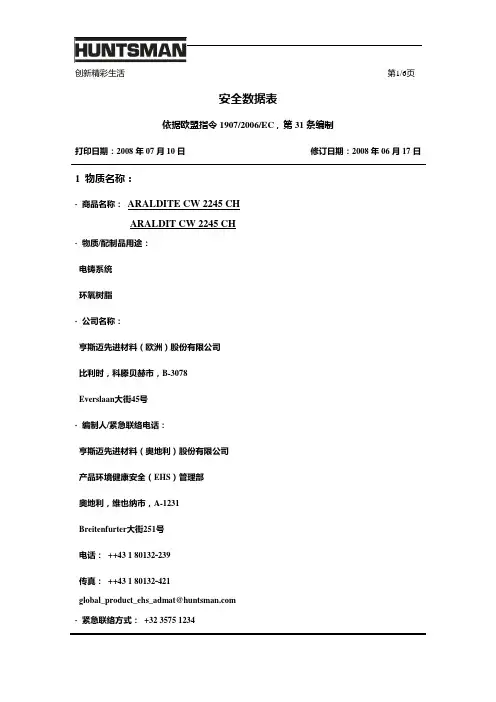
创新精彩生活 第1/6页安全数据表依据欧盟指令1907/2006/EC ,第31条编制打印日期:2008年07月10日 修订日期:2008年06月17日1 物质名称: · 商品名称: ARALDITE CW 2245 CHARALDIT CW 2245 CH· 物质/配制品用途: 电铸系统 环氧树脂 · 公司名称:亨斯迈先进材料(欧洲)股份有限公司 比利时,科滕贝赫市,B-3078 Everslaan 大街45号 · 编制人/紧急联络电话:亨斯迈先进材料(奥地利)股份有限公司 产品环境健康安全(EHS )管理部 奥地利,维也纳市,A-1231 Breitenfurter 大街251号 电话: ++43 1 80132—239 传真: ++43 1 80132—421global_product_ehs_admat@ · 紧急联络方式: +32 3575 12342 危害信息· 危害标识:Xi 有刺激性N 对环境有害· 对健康和/或环境存在危害: R 36/38 刺激眼睛和皮肤。
R 43 皮肤接触可能引起过敏。
R 51/53 对水生生物有毒,可能在水生环境中造成长期不利影响。
含有环氧树脂成分。
可查阅制造商提供的产品信息。
· 一般信息 立即脱去任何被本产品污染的衣物。
· 吸入 供应新鲜空气;一旦发病,立即就医诊察。
·皮肤接触立即用水和肥皂冲洗,并彻底清洗干净。
如果继续刺激皮肤,请就医诊察。
·眼部接触眼睛睁开状态下用流动水冲洗若干分钟。
如果症状持续,请就医诊察。
·摄入漱口,大量饮水。
不得使用催吐药剂;立即就医治疗。
(第2页续本节)第2/6页安全数据表依据欧盟指令1907/2006/EC,第31条编制打印日期:2008年07月10日修订日期:2008年06月17日商品名称:ARALDITE CW 2245 CHARALDIT CW 2245 CH(续第1页)若患者平躺时呕吐,应立即侧卧。
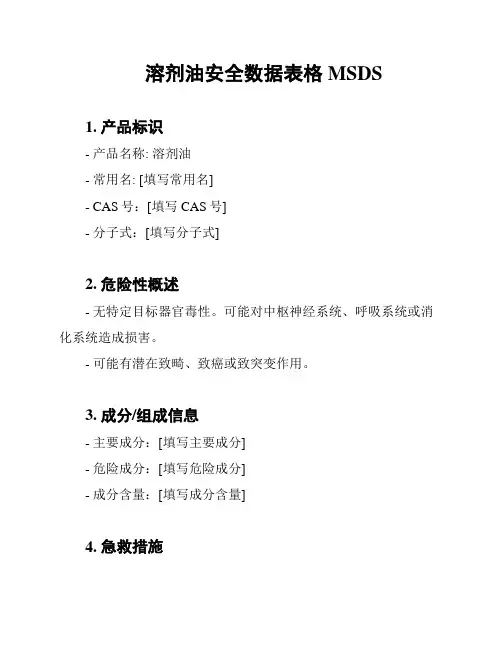
溶剂油安全数据表格MSDS1. 产品标识- 产品名称: 溶剂油- 常用名: [填写常用名]- CAS号:[填写CAS号]- 分子式:[填写分子式]2. 危险性概述- 无特定目标器官毒性。
可能对中枢神经系统、呼吸系统或消化系统造成损害。
- 可能有潜在致畸、致癌或致突变作用。
3. 成分/组成信息- 主要成分:[填写主要成分]- 危险成分:[填写危险成分]- 成分含量:[填写成分含量]4. 急救措施- 吸入:将患者转移到新鲜空气处休息。
如呼吸困难持续,请立即就医。
- 眼部接触:立即用大量清水冲洗至少15分钟。
若持续不适,请就医。
- 皮肤接触:立即脱去污染衣物,用温和的肥皂和水彻底清洗受污染部位。
若持续不适,请就医。
- 摄入:勿用催吐。
若意识清醒,饮用大量水,可尽快就医。
5. 消防措施- 消防器材:选择合适的灭火剂,如干粉、水雾、二氧化碳等。
- 防护措施:穿戴合适的防护装备,包括耐化学品手套、阻燃服装等。
6. 泄漏应急处理- 隔离泄漏区域,远离火源和点燃可能。
- 确保适当通风,并配备适合的个人防护装备。
- 通过吸附剂或合适的阻隔物吸收泄漏物。
7. 使用与储存- 使用时注意良好通风环境,避免吸入气体或蒸气。
- 储存在阴凉、干燥的地方,远离火源和点燃可能。
- 避免与氧化剂、酸、碱等物质接触。
8. 接触控制/个人保护- 呼吸保护:在通风不良或浓度过高的情况下,佩戴合适的呼吸防护设备。
- 眼睛保护:佩戴密闭式安全护目镜。
- 皮肤接触:穿戴防护手套、防护服等。
- 其他措施:遵循良好的工作卫生实践,及时更换受污染的衣物。
9. 理化特性- 外观:[填写外观描述]- PH值:[填写PH值]- 相对密度:[填写相对密度]- 熔点/凝固点:[填写熔点/凝固点]- 沸点/沸程:[填写沸点/沸程]- 可燃性:[填写可燃性]- 闪点:[填写闪点]- 爆炸上下限:[填写爆炸上下限]10. 环境处置- 避免将产品排放到环境中,遵守当地环保法规。
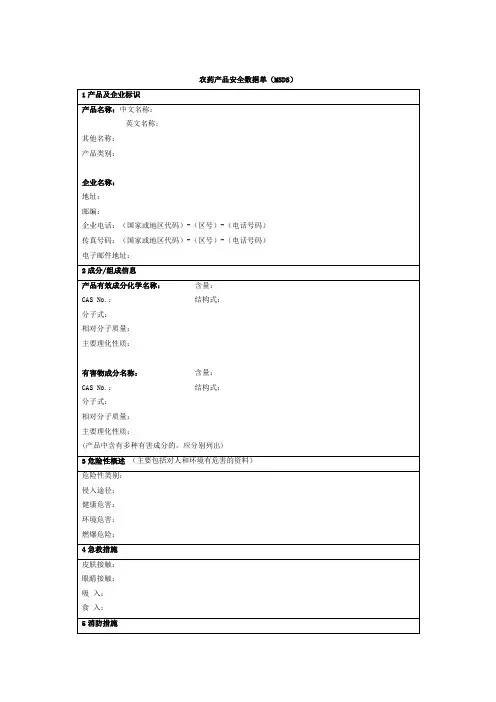

版本/修改号:A/0 标识号/:CDZ-MSDS-021物料安全数据表(MSDS)发布日期:2005 年6月7日1.0产品识别/ 产品名称及类型:埃索500#传热油,压缩机油/传热传动油―――――――――――――――――――――――――――――――――――――――2.0危险成分/由高度精炼石蜡基础油调配而成3.0物理数据/埃索500#传热油在封闭系统中,整体油温可高达316℃,而在热源接触面可抵受360℃的界面温度。
在开放式系统中,与空气的接触界面,其油温应保持在190℃以下。
防止积碳和油泥的形成。
☉具低挥发,低蒸气压及高闪点,可防止循环泵中因气塞而导致密封系统产生过高压力。
☉高粘度指数及低倾点,在低温下仍保持操作畅通。
☉高比热值,热传导性佳,能提供良好的传热效率。
压缩机油☉具良好的抗氧化及热稳定性,能低受严苛的环境,如高压缩比率下操作。
☉碳化倾向低,能使阀门保持清洁。
☉良好的抗乳化性,使压缩空气冷却时凝结的水分容易被分离。
☉低蒸气和挥发性。
―――――――――――――――――――――――――――――――――――――――4.0燃烧与爆炸资料/4.1特别燃烧危险:无―――――――――――――――――――――――――――――――――――――――5.0反应资料5.1稳定性:具有特佳的热稳定性,氧化稳定性,―――――――――――――――――――――――――――――――――――――――6.0溢出或泄漏处置/使用适当的保护设备6.1清洗:用抹布擦。
6.2废物处理:放入指定的容器,并交给危险品仓库处理。
―――――――――――――――――――――――――――――――――――――――7.0健康危险资料/过度接触浓缩物的影响7.1皮肤和眼睛:无,如高温接触皮肤会烫伤。
7.2吞咽:少量摄入无害。
7.3吸入:无害。
―――――――――――――――――――――――――――――――――――――――8.0急救/8.1眼睛:用清水冲洗8.2皮肤:如热液需用冷水冲洗,用肥皂洗干净并涂烫伤膏8.3吞咽:洗胃8.4吸入:无害―――――――――――――――――――――――――――――――――――――――9.0预防措施/9.1呼吸:无9.2眼睛:无9.3皮肤:使用防渗透手套―――――――――――――――――――――――――――――――――――――――10.1存放注意事项:产品请置于儿童不能接触之地方。
MSDS物质安全资料表001 乙炔气002 氧气003 二氧化碳004 氢气005 氩气006 甲烷007 四氢噻吩008 活性炭009 三乙胺010 硫代磷酰氯011 硫黄012 甲胺磷013 多聚甲醛014 甲缩醛015 黄磷016 氯017 三氯化磷018 甲醇019 液碱020 氨水021 硫酸二甲酯022 甲胺磷023 液氨024 氯仿025 二氯乙烷026 二硫化碳027 甲苯028 盐酸029 氯甲烷030 硫酸031 二甲苯032 醋酸酐033 多聚甲醛034 草甘膦035 稻瘟灵036 异丙胺037 漂白粉038 氯化氢039 氰化氢040 氰化钠041 氯乙酸042 甲缩醛043 丙烯腈044 氧化亚铜045 四氯化锡046 四氧化三铅047 三氯化铝(无水)048 松香水049 红丹油性防锈漆050 酚醛树脂051 硫磺粉(补充)052 一乙胺053三聚氯氰054 三氯乙烯055 磷酸056 四丁基锡057 柴油058 对氨基苯酚059 醋酸乙酯060 对氯硝基苯061 氮气062莠去津063 扑草净064 八氯二丙醚065 硫化钠066 异丙醇067 丙酮068 二氯丙烷069 环己酮070 乙酸异戊酯071 锌粉072 乙醇073 次氯酸钠溶液074 石脑油075 双环戊二烯076 乙酸丁酯077 双氧水078 丙烯酸丁酯079 丙烯酸080 苯乙烯081 过硫酸铵082 过硫酸钾083 丙烯酰胺084 甲醛085 甲基丙烯酸甲酯086 甲基丙烯酸087 汽油088 乙酸089 丙烯酸树脂090 丙烯酸清漆091 丙烯酸漆稀释剂092 丙烯酸磁漆093 二乙醇胺094 煤油095 漂白粉096 漂粉精097 三氯异氰尿酸098 松香099 松节油100 硫化钠101 保险粉102 7385聚氨酯清漆(分装)103 甲酸104 乙酸乙二醇乙醚105 H-3聚氨酯漆固化剂106 聚氨酯漆稀释剂107 263醇酸树脂108 异噻唑啉酮109 N-乙基苯胺110 苯胺111 乙酰甲胺磷112 亚磷酸113 亚磷酸二甲酯114 氯甲烷115 乙醚116 丙烯酸甲酯117 一甲胺118 硝酸镁119 硫化氢120 硫化铵121 一甲胺水溶液122 兔宝宝面漆123 兔宝宝稀释剂124 硫氢化钠125 丙酸126 乙酰氯127 丙酰氯128 丁醇129 醇酸调合漆130 硝酸钠131 溴甲烷132 磷化铝133 正丁醇134 硝基木器漆135 硝化棉(含氮≤12.6%)136 单丁醚137 砷138 碘化汞139 氯化汞140 叠氮化钠141 重铬酸钠142 高锰酸钾143 氰化金钾144 丙烯酸145 甲基丙烯酸甲酯146 苯乙烯147 丙烯酸丁酯148 丁醇149 偶氮二异丁腈150 甲基丙烯酸异丁酯151 甲基丙烯酸(正)丁酯152 乙酰丙酮153 2-丁酮154 生松香155 硫酸铜156 硝酸157 氰化钾158 硝基苯159 氟化钠160 氢氟酸161 蓄电池(注有酸液)162 环氧树脂163 氯苯164 乙苯165 樟脑166 赛璐珞167 氢氧化钾168 乙酸丁酯169 NN-二甲基甲酰胺170 叔丁胺171 氯化亚砜172 碳化钙、电石001 乙炔气标识中文名:乙炔英文名:acetylene分子式:C2H2 分子量:26.04 CAS号:74-86-2 危规号:21024理化性质性状:无色无臭气体,工业品有使人不愉快的大蒜气味溶解性:微溶于水、乙醇,溶于丙酮、氯仿、苯熔点(℃):-81.8(119kpPa)沸点(℃):-83.8 相对密度(水=1):0.62临界温度(℃):35.2 临界压力(MPa):6.14 相对密度(空气=1):0.91燃烧热(KJ/mol):1298.4 最小点火能(mJ):饱和蒸汽压(KPa):4053(16.8℃)燃烧爆炸危险性燃烧性:易燃燃烧分解产物:一氧化碳、二氧化碳闪点(℃):无意义聚合危害:聚合爆炸下限(%):2.1 稳定性:稳定爆炸上限(%):80.0 禁忌物:强氧化剂、强酸、卤素引燃温度(℃):305 最小点火能(mJ):0.02危险特性:极易燃烧爆炸。